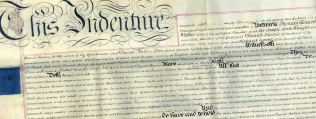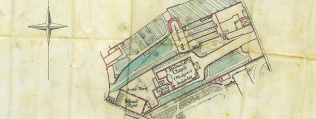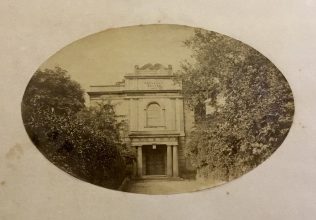Oxford: New Inn Hall Street Chapel
1818 - 1878





This was the first purpose build Methodist Chapel in Oxford. It was designed by William Jenkins and opened in 1818.
Ministers who served at this Chapel.
Unpromising Beginnings
Methodism had a hard time in Oxford during the years after John Wesley’s death in 1791. Non-conformism was portrayed as ill conceived, dangerously led by uneducated preachers and dubious in its patriotism – a particularly alarming suggestion in the light of the international situation at the time with republicanism being established in America and France.The powerful University opposed Methodism and there was much suspicion and some discrimination from the general public.
Investing in Faith
Despite these setbacks and partly due to unexpected support from benefactors, in 1815 Oxford Methodists decided to build their own chapel. One of the first challenges was to find a suitable site. Few wanted to be seen to help the Methodist cause.
Land acquired from Daniel Harris
Trustees were eventually able to purchase a plot of ground at the northern end of New Inn Hall Lane from Daniel Harris in 1817. Harris was a former Clerk of Works and then Governor of Oxford Castle turned builder, developer and architect.
It is said that his friends tried to stop the sale by asserting Harris was a lunatic and unfit to manage his business affairs. Considering Harris’s respected position in the city, this indicates just how low the status of Methodism was in Oxford at that time.
Chapel designed by William Jenkins
The well-respected Wesleyan Methodist minister-cum-architect William Jenkins was commissioned to design the new building in the classical style. It had a pillared portico and three arched windows above, topped with an elaborate pediment. There was an apse at the rear, possibly for the communion area – a feature Jenkins would have been familiar with from Wesley’s Chapel in London.
Originally, there was neither a balcony nor an organ. The chapel stood well back from New Inn Hall Lane with a wide gravelled yard in front of it. On each side and adjacent to the street were houses, one for the minister and the other for the chapel keeper.
The University was not Supportive
Rev Edward Tatham, Rector of Lincoln College, a controversial figure and a long-term critic, objected to the scale of the building. He allegedly tried to have the building work halted but was not successful. It is said that the Proctor walked in during the opening service, closely surveying the congregation to check there were no students in attendance. Finding none, he left!
The Chapel Opens
Begun in 1817, the chapel was officially opened on 19 February 1818. Over this day and the following Sunday four leading Methodists were invited to preach: the Rev Dr Adam Clarke, the Rev Joseph Benson, the Rev Jabez bunting and the Rev Richard Watson. A payment of 10 shillings for the attendance of two constables at this time suggests either that large crowds were expected or trouble was feared – possibly both.
The Building was almost Immediately Extended
Despite being burdened by a large debt, a schoolroom (also designed by William Jenkins) was built at the back of the Chapel in 1819 and a gallery added in 1820.
Outreach Activity Begins
The original school was both a Day and Sunday School, teaching the basics of an elementary education as well as Christian doctrine, as there was no state system of education at the time. Sunday schools were originally provided for children who had to work on other days of the week.
A Missionary Society was formed in 1819 raising money to support missionary work overseas and putting on popular public lectures given by missionaries who had returned from service and were able to give first hand accounts of their work and foreign adventures.
Missionaries were the honoured explorers of their day. Life expectancy was short and conditions were harsh. Only the strong survived the ordeal. They attracted large audiences on their return.
A Tract Society was formed in 1820, giving a structure to the visiting of households in the neighbourhood, which in turn encouraged people to come to the chapel.
Printed pamphlets were cheap to produce and provided a welcome sources of reading materials for those who could not afford books. It may seem surprising to us that an example such as A Friendly Caution Against Intemperance would encourage exploration of Christian faith and a sense of wanting to belong. However, the regular visit by a church member delivering the tracts was probably as important as the reading material itself.
Generous benefactor aids expansion of outreach
In 1825, Henry Goring, an Anglican resident of Oxford presented the Church with £2500. This enabled the trustees to clear both the chapel and school building fund debts. A new school was built adjacent to Bullwarks Lane and other alterations were carried out in 1831.
Outrage subsides and relationships improve
In 1854 the University of Oxford began to admit non-Anglican students and the abolition of religious tests for fellowships followed in 1871. This transformed the relationship between the Church and the University.
The sons of Methodist families and particularly ministers’s sons were able to attend the University and formed a vibrant part of church life. Increasingly, trustees were local businessmen, farmers and mens of men of standing in the city.
Sixty years of worship and service
Changing perspectives about the type of architecture that was suitable for Methodist buildings and the chapel’s relatively modest size led to the development of plans for a much larger church immediately in front of the 1818 building.
The chapel building continued to be of use after the opening of Wesley Memorial Church in 1878. The chapel provided teaching space for both the school and the church. It was eventually sold to St Peter’s College in the 1930s to fund the building of the present church halls. It was demolished in 1969.





No Comments
Add a comment about this page